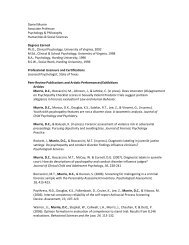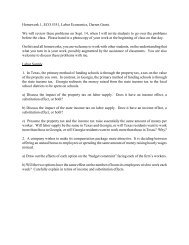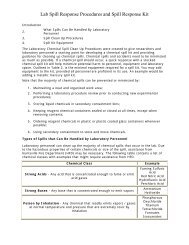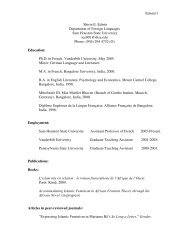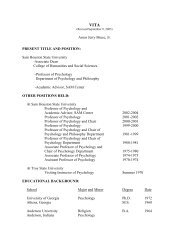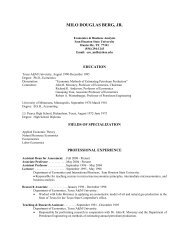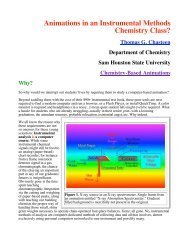Terraforming Mars Group Discussion
Terraforming Mars Group Discussion
Terraforming Mars Group Discussion
You also want an ePaper? Increase the reach of your titles
YUMPU automatically turns print PDFs into web optimized ePapers that Google loves.
<strong>Terraforming</strong> <strong>Mars</strong> <strong>Group</strong> <strong>Discussion</strong><br />
<strong>Group</strong> Assignment<br />
Meet with the other members of your group. Assign group roles. Print names below.<br />
Your name must appear below in order to receive credit.<br />
Recorder - writes down group’s ideas<br />
Timekeeper - keeps the group on task within time allowed<br />
Mediator - helps group arrive at a consensus, oversees voting on issues<br />
Clarifier - reads while Recorder writes, makes sure everyone understands<br />
Encourager - makes sure everyone contributes, encourages group members to talk<br />
Speaker - proposes any group questions to TA/Instructor<br />
(In groups of 5, the Encourager is also the Speaker)<br />
Reporter - summarizes group’s findings (at the end of the discussion time anyone in the group may<br />
be asked to serve as the Reporter)<br />
In this group discussion, students will compare Earth and <strong>Mars</strong>, and think about the possibility and<br />
implications of terraforming <strong>Mars</strong>. After completing this exercise, students should be able to state the<br />
steps necessary to turn <strong>Mars</strong> into a planet that would support life as we know it, discuss how this<br />
technology might be used to solve problems on Earth, and debate the moral considerations regarding<br />
our right to terraform <strong>Mars</strong>.<br />
I. CONDITIONS ON MARS<br />
Scientists hypothesize that in the past <strong>Mars</strong> was a warmer, wetter planet.<br />
What evidence have you come across in your general astronomy class that supports<br />
this hypothesis?<br />
1
Observations imply that conditions on <strong>Mars</strong> were different in the past than they are today, such that<br />
it was a much warmer planet with a sizable atmosphere. Unfortunately, Martian low gravity (0.38 times<br />
that of Earth’s) and soil conditions caused the water and atmosphere to either be absorbed into the<br />
soil and/or escape from <strong>Mars</strong>. Current conditions on <strong>Mars</strong> are far from hospitable. Approximately 1.5<br />
times farther from the Sun than the Earth, <strong>Mars</strong> receives only about 43% the sunlight Earth receives.<br />
Its atmosphere is very thin, only 0.8% as thick as Earth’s atmosphere, and is composed mainly of<br />
carbon dioxide (about 95%). The result is a mean temperature of -75 ◦ F (-59 ◦ C), inhospitable to even<br />
the heartiest of lifeforms.<br />
II. STEP ONE - WARMING THE PLANET<br />
In 1991, three planetary scientists (Christopher McKay, Owen Toon, and James Kasting) published<br />
a comprehensive paper on the process of terraforming <strong>Mars</strong>. They outlined the steps they thought<br />
were necessary to transform <strong>Mars</strong> into a planet similar to Earth, one that could support life as we<br />
know it. The first step involved sending an unmanned robot to <strong>Mars</strong> which would release greenhouse<br />
gases (mainly chlorofluorocarbons-CFCs, which could be manufactured from materials already found<br />
on <strong>Mars</strong>) into the Martian atmosphere.<br />
What are some of the more common greenhouse gases?<br />
What is the greenhouse effect and how does it work on Earth?<br />
The main result of the introduction of greenhouse gases would be to raise temperatures on <strong>Mars</strong><br />
until carbon dioxide is released from solid to gas from the polar caps and Martian soil. Since carbon<br />
dioxide is a greenhouse gas, this would not only aid in increasing the atmosphere of <strong>Mars</strong> but would<br />
also help increase temperatures further. As <strong>Mars</strong> becomes hotter still, temperatures would rise to the<br />
point that frozen water would be released to gas, another greenhouse gas. In order to reach this stage,<br />
a few problems need to be overcome. Ultraviolet (UV) light tends to destroy CFCs. Therefore, either<br />
a steady supply of CFCs would have to be used or a CFC resistant to UV light would have to be<br />
created.<br />
2
What mechanisms remove some of the greenhouse effect gases from the atmosphere<br />
on Earth?<br />
Once temperatures are high enough for water to exist in liquid form, CO2 would have the tendency<br />
to dissolve in the water and react with existing silicate rock to form carbonate rock. Therefore, a<br />
method to recycle the CO2 would be required. The CO2 may be trapped deep within the Martian<br />
soil. This stage of terraforming could take up to 100,000 years.<br />
With such a long implementation time, is terraforming a realistic idea? Discuss.<br />
III. STEP TWO - CREATING OXYGEN<br />
The rock record indicates that there was not much oxygen present in Earth’s atmosphere more than<br />
2 billion years ago. Older rocks that formed more than 2 billion years ago could only have formed<br />
without oxygen present, like lead sulfide. Rocks that formed more recently, less than 2 billion years<br />
ago, could only have formed in the presence of oxygen, like lead sulfate.<br />
How did oxygen become so dominant in Earth’s atmosphere?<br />
Once temperatures have risen moderately and enough carbon dioxide is released into the atmosphere,<br />
<strong>Mars</strong> would be able to support a few species of plants. To aid the growth of the plants,<br />
organisms could be released into the soil to free up some of the nitrates and nitrites. At the present<br />
rate, it would take plants about 100,000 years to convert enough carbon dioxide into oxygen by photosynthesis<br />
for man to survive. It might be possible to develop more efficient oxygen-converting plants,<br />
but genetic engineers suggest that plants may be as efficient as they are going to get. Plants have<br />
been around for billions of years and may not be able to produce any more oxygen than they currently<br />
produce. If plant efficiencies could be increased, engineers hypothesize that it would still take about<br />
1,000 years to produce enough oxygen. As oxygen builds up, an ozone layer could develop.<br />
Why is ozone important?<br />
3
IV. JUST BECAUSE WE CAN, SHOULD WE?<br />
Once oxygen levels (O2) reached the right level (about 20% of the atmosphere), <strong>Mars</strong> would be<br />
remarkably like Earth. With minor help from humans, such as the creation of ozone-friendly CFCs to<br />
help maintain a moderate greenhouse effect and the recycling of carbon dioxide captured by the soil<br />
and water, humanity would be able to inhabit <strong>Mars</strong>.<br />
Just because we are able to transform <strong>Mars</strong>, do we have the right to do so? Why or<br />
why not?<br />
Some argue that we shouldn’t even consider terraforming <strong>Mars</strong> while there are still problems here<br />
on Earth. Should we terraform <strong>Mars</strong> when conditions on Earth are currently less than<br />
ideal? Discuss.<br />
Can your group think of any ways terraforming techniques could be used to help<br />
correct some of the problems on Earth? Discuss.<br />
Others argue that to terraform <strong>Mars</strong> would be tampering with its natural state. An argument<br />
against this is that we currently change Earth’s natural state to suit our needs by irrigating fields or<br />
planting trees in open areas.<br />
Do you believe we should try to change the Martian environment? Support your answer.<br />
4
Assume that your group is a committee assigned to vote on the proposal to terraform <strong>Mars</strong>.<br />
What would be your committee’s recommendation? Should we terraform <strong>Mars</strong> now or<br />
wait until a later time, or not terraform <strong>Mars</strong> at all? If not, what should we do instead?<br />
Explain.<br />
5



